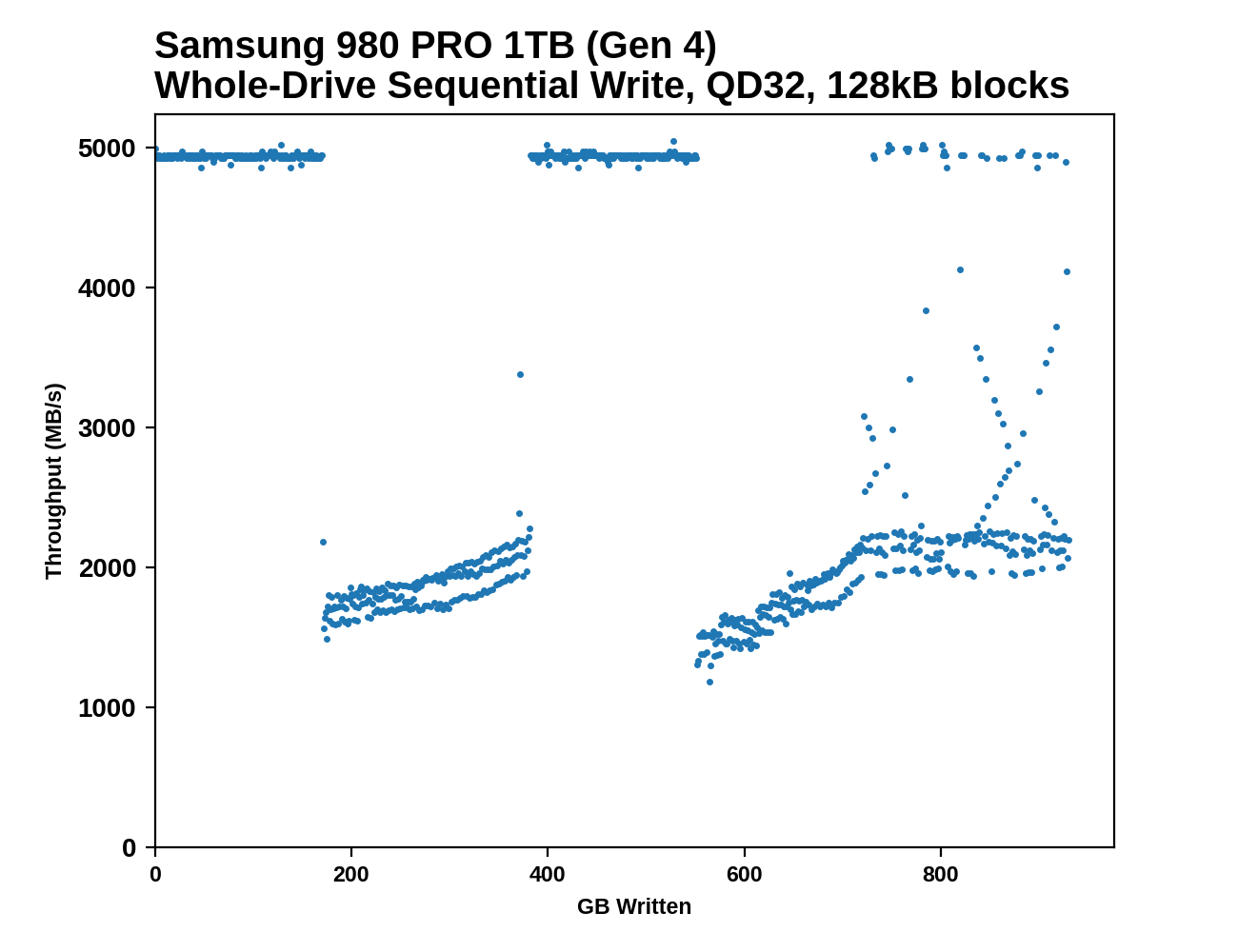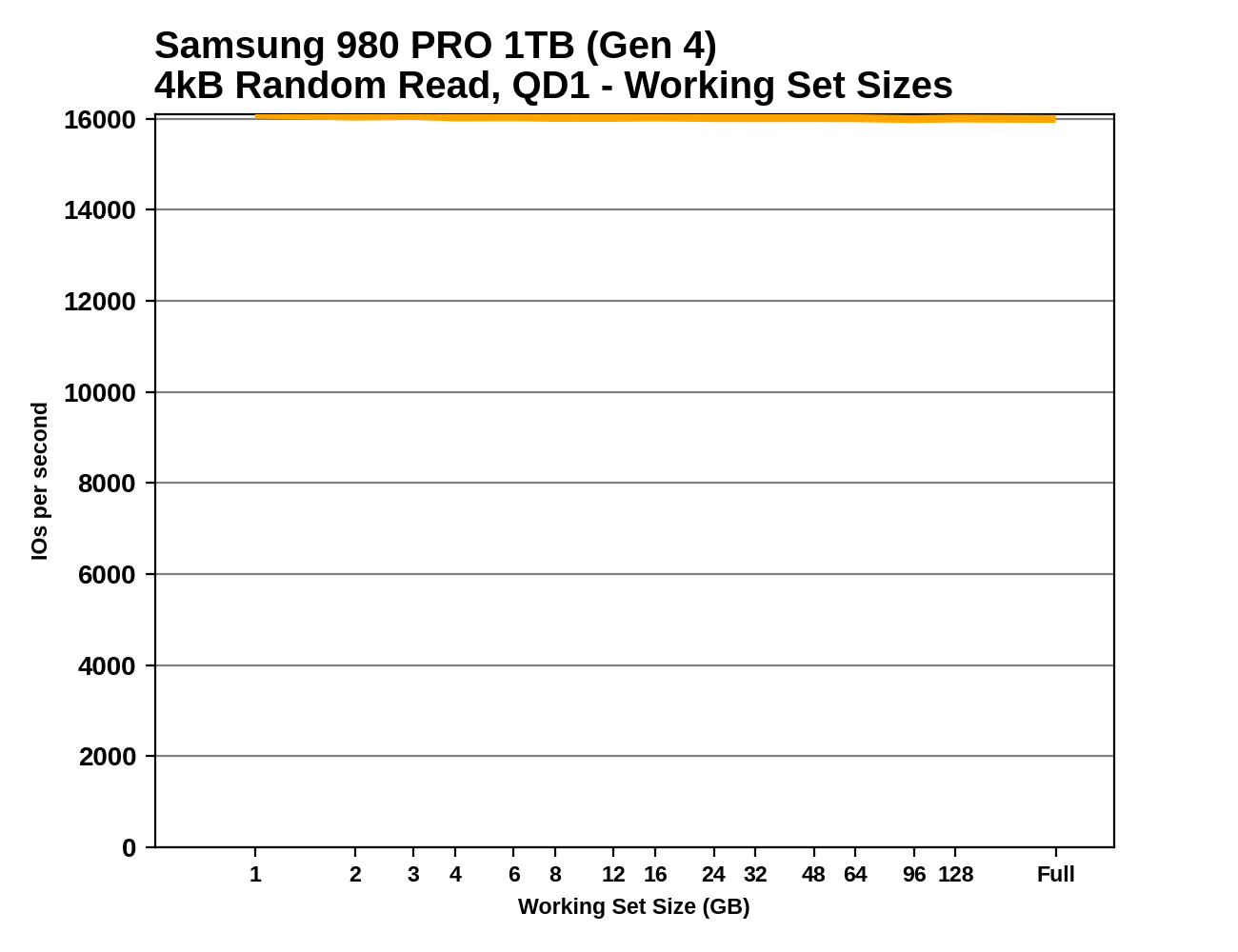The Samsung 980 PRO PCIe 4.0 SSD Review: A Spirit of Hope
by Billy Tallis on September 22, 2020 11:20 AM ESTWhole-Drive Fill
This test starts with a freshly-erased drive and fills it with 128kB sequential writes at queue depth 32, recording the write speed for each 1GB segment. This test is not representative of any ordinary client/consumer usage pattern, but it does allow us to observe transitions in the drive's behavior as it fills up. This can allow us to estimate the size of any SLC write cache, and get a sense for how much performance remains on the rare occasions where real-world usage keeps writing data after filling the cache.
 |
|||||||||
Both tested capacities of the 980 PRO perform more or less as advertised at the start of the test: 5GB/s writing to the SLC cache on the 1TB model and 2.6GB/s writing to the cache on the 250GB model - the 1 TB model only hits 3.3 GB/s when in PCIe 3.0 mode. Surprisingly, the apparent size of the SLC caches is larger than advertised, and larger when testing on PCIe 4 than on PCIe 3: the 1TB model's cache (rated for 114GB) lasts about 170GB @ Gen4 speeeds and about 128GB @ Gen3 speeds, and the 250GB model's cache (rated for 49GB) lasts for about 60GB on Gen4 and about 49GB on Gen3. If anything it seems that these SLC cache areas are quoted more for PCIe 3.0 than PCIe 4.0 - under PCIe 4.0 however, there might be a chance to free up some of the SLC as the drive writes to other SLC, hence the increase.
An extra twist for the 1TB model is that partway through the drive fill process, performance returns to SLC speeds and stays there just as long as it did initially: another 170GB written at 5GB/s (124GB written at 3.3GB/s on Gen3). Looking back at the 970 EVO Plus and 970 EVO we can see similar behavior, but it's impressive Samsung was able to continue this with the 980 PRO while providing much larger SLC caches—in total, over a third of the drive fill process ran at the 5GB/s SLC speed, and performance in the TLC writing phases was still good in spite of the background work to flush the SLC cache.
 |
|||||||||
| Average Throughput for last 16 GB | Overall Average Throughput | ||||||||
On the Gen4 testbed, the overall average throughput of filling the 1TB 980 PRO is only slightly slower than filling the MLC-based 970 PRO, and far faster than the other 1TB TLC drives. Even when limited by PCIe Gen3, the 980 Pro's throughput remains in the lead. The smaller 250GB model doesn't make good use of PCIe Gen4 bandwidth during this sequential write test, but it is a clear improvement over the same capacity of the 970 EVO Plus.
Working Set Size
Most mainstream SSDs have enough DRAM to store the entire mapping table that translates logical block addresses into physical flash memory addresses. DRAMless drives only have small buffers to cache a portion of this mapping information. Some NVMe SSDs support the Host Memory Buffer feature and can borrow a piece of the host system's DRAM for this cache rather needing lots of on-controller memory.
When accessing a logical block whose mapping is not cached, the drive needs to read the mapping from the full table stored on the flash memory before it can read the user data stored at that logical block. This adds extra latency to read operations and in the worst case may double random read latency.
We can see the effects of the size of any mapping buffer by performing random reads from different sized portions of the drive. When performing random reads from a small slice of the drive, we expect the mappings to all fit in the cache, and when performing random reads from the entire drive, we expect mostly cache misses.
When performing this test on mainstream drives with a full-sized DRAM cache, we expect performance to be generally constant regardless of the working set size, or for performance to drop only slightly as the working set size increases.
 |
|||||||||
Since these are all high-end drives, we don't see any of the read performance drop-off we expect from SSDs with limited or no DRAM buffers. The two drives using Silicon Motion controllers show a little bit of variation depending on the working set size, but ultimately are just as fast when performing random reads across the whole drive as they are reading from a narrow range. The read latency measured here for the 980 PRO is an improvement of about 15% over the 970 EVO Plus, but is not as fast as the MLC-based 970 PRO.










137 Comments
View All Comments
jeremyshaw - Tuesday, September 22, 2020 - link
Given how fast the TLC was when the SLC cache was exhausted (and was undoubtedly working on flushing the SLC cache into TLC), I wonder how much faster the native TLC mode of the SSD could be?Billy Tallis - Tuesday, September 22, 2020 - link
Their ISSCC 2019 presentation about the 512Gbit 128L die (which will be used in the 2TB 980 PRO) claims a write speed of 82MB/s per die. The 1TB 980 PRO is using a total of 32 of the 256Gbit dies, and if it's the same speed then that would work out to 2624 MB/s. So that suggests the total drive fill process is barely slowed down at all by the SLC caching dance, and a datacenter drive using this NAND and controller could hit almost twice the write throughput the current 960GB 983 DCT is rated for.System75 - Wednesday, September 23, 2020 - link
Why don't you test a fully filled SSD performance anymore like you used to in AnandTech Storage Bench - Heavy? An empty 980 pro drive performance is not what its target consumer wants to know.alyarb - Tuesday, September 22, 2020 - link
thanks for the memories Samsung, but I'm outnandnandnand - Tuesday, September 22, 2020 - link
Is the Spirit of Hope dead?Hyoyeon - Tuesday, September 22, 2020 - link
That SK Hynix P31 could become my new favorite drive.Hifihedgehog - Tuesday, September 22, 2020 - link
Not quite. The P31 is an amazing value, but I have yet to find a lower latency drive than a Samsung. The P31 does nip at the heels and even surprises in some tests, but it still falls massively short in many latency-sensitive situations where it is easily outclassed by the 970 EVO Plus and above. You get what you pay for.https://www.storagereview.com/review/sk-hynix-gold...
https://www.storagereview.com/review/sk-hynix-gold...
lmcd - Tuesday, September 22, 2020 - link
For laptop usage that latency is not even close to worth it. I'm optimistic the upgrade from a 970 EVO (don't worry, it's primarily for a capacity upgrade) will help my inefficient Ryzen 2700U hold on a bit longer when off the charger.MikeMurphy - Tuesday, September 22, 2020 - link
The P31 performs admirably and does so while consuming very little power and producing very little heat. It doesn't trounce the Samsung drives in every metric but at that price and power budget it doesn't have to.Samus - Wednesday, September 23, 2020 - link
If Hynix wanted to crank up the heat and power consumption, there is nothing stopping them operating the controller at a higher frequency to reduce the latency caused by processing overhead.But they realize there is no need for this at the moment as they have a product that is class-leading in a class it doesn't even compete in.